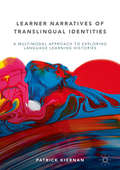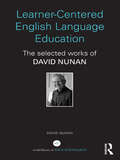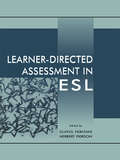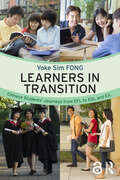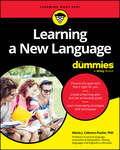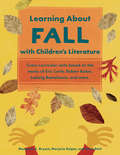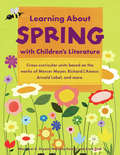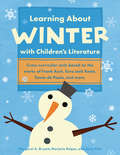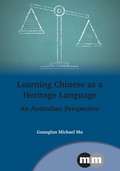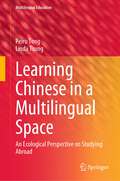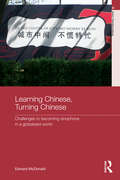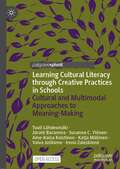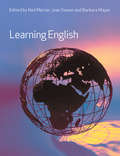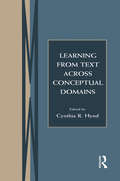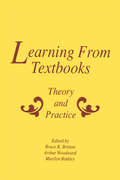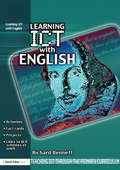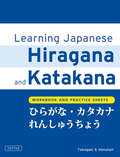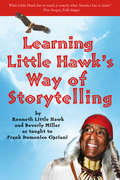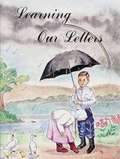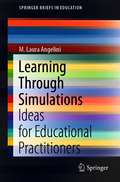- Table View
- List View
Learner Narratives of Translingual Identities: A Multimodal Approach to Exploring Language Learning Histories
by Patrick KiernanThis book addresses translingual identities through an innovative multimodal analysis of the language learning histories of a class of advanced learners of English in Japan who grew up between two or more languages. The author explores both the translingual experiences of those in the classroom and how they use language and gesture when describing their experiences to each other. This approach uses three perspectives: it looks at the worlds and identities the interviewees construct for themselves; at their interpersonal communication; and at the way they frame their experience. Finally, it offers some lessons based on the observations of the class which reveal the values they share and the key to their success as language learners. It will appeal to applied linguistic and educational researchers, particularly those with an interest in narrative approaches to exploring educational contexts, as well as language educators and policy makers interested in gaining a learner perspective on language learning.
Learner-Centered English Language Education: The Selected Works of David Nunan
by David NunanThis carefully crafted collection provides a snapshot of the evolution of David Nunan‘s theoretical and empirical contributions to the field of second language education over the last 40 years. The volume focuses on the development of his work on second language curricula, and in particular, the work for which he is best known: learner-centered education and task-based learning and teaching. David Nunan has been a language teacher, researcher and consultant for 40 years. He has lived and worked in many countries, principally in the Asia-Pacific region, but also in the Americas, Europe and the Middle-East. In addition to his research and scholarly work, he is the author of several major textbook series for the teaching and learning of English as a foreign Language. These texts are based on his task-based language teaching approach, and are widely used in schools, school systems and universities around the world.
Learner-directed Assessment in Esl
by Glayol V. Ekbatani Herbert D. PiersonThis text integrates the theory and practice of learner-based assessment. Written in response to two recent movements in language teaching--learner-centered teaching and a renewed interest in authenticity in language testing--it examines the relationship between the language learner and language assessment processes, and promotes approaches to assessment that involve the learner in the testing process. Particular attention is given to issues of reliability and validity. Grounded in current pedagogical applications of authentic assessment measures, this volume is intended for and eminently accessible to classroom teachers and program directors looking for ways to include their students in the evaluation process, graduate students, and professional language testers seeking authenticity in assessment and desiring to create more interactive evaluation tools.
Learners in Transition: Chinese Students’ Journeys from EFL to ESL and EIL
by Yoke Sim FongAs the number of Chinese students learning English increases worldwide, the need for teachers to understand the characteristics and challenges facing this group of learners grows. This is particularly true for those students moving from an English as a Foreign Language context to an English as a Second Language/International Language one where they experience academic, linguistic and sociocultural transitions. Drawing on over 20 years’ experience teaching English courses to Chinese learners, the author aims to highlight key findings to aid understanding, improve teachers’ practice and offer pedagogical recommendations. Using students’ voices, the book covers: how the traditional Chinese culture of learning plays a role; how new learning contexts provide opportunities and empowerment; how learners’ beliefs and strategies are interconnected; how their motivation and identity underscore the power of real and imagined communities, and finally, that affect matters, showing how learners are propelled by the trajectory of their emotions. The book cites from the rich data collected over a five-year period to authenticate the findings and recommendations but also to give voice to this group of learners to challenge the stereotype of the passive "Chinese learner". The essential insights contained within are useful for pre- and in-service teachers of English and researchers interested in language education around the world.
Learning A New Language For Dummies
by Maria J. Cabrera-PucheStrategies, tools, and motivation for learning a new language Learning A New Language For Dummies explains how you can create a personal plan to achieve your language learning goals. Get research-based suggestions for speeding up your language acquisition and learn about the benefits of leveling up your linguistic ability. Even if you've never studied a language before, this easy-to-understand guide will prepare you to pick the learning methods that will work best for you. You#ll also get an intro to the basics of how humans learn languages, so you can stay motivated, set realistic goals, and achieve success. No matter what language you want to learn, this Dummies guide will help you start off on the right foot. Choose a language learning approach that fits you and your lifestyle Get step-by-step guidance for making a plan and setting achievable goals Learn techniques and strategies for learning quicker and retaining more Improve your odds of success with a foundation of knowledge about the learning process Anyone considering learning a new language or refreshing their knowledge of a language—and language teachers, too—will love Learning a New Language For Dummies.
Learning About Fall with Children's Literature: Cross-curricular Units Based On The Works Of Eric Carle, Robert Kalan, Ludwig Bemelmans And More
by Margaret Bryant Anne Petit Marjorie KeiperTaking a thematic approach to learning that employs seeing, hearing, reading, and writing, these books outline three four-week, cross-curricular units that develop the competencies children need to become fluent, independent readers and writers. While each unit focuses primarily on language--phonic skills, structural analysis, punctuation, capitalization, poetry, and comprehension--they also include math, science, social studies, music, art, and even mini-lessons in French for cross-cultural appreciation. Understanding that student ability levels in younger grades can vary widely, lesson plans are keyed to three types of learners: emerging, typical, and advanced. The series includes three titles that cover fall, spring, and winter, and each can be used independently or together throughout the school year.
Learning About Spring with Children's Literature
by Margaret Bryant Anne Petit Marjorie KeiperTaking a thematic approach to learning that employs seeing, hearing, reading, and writing, these books outline three four-week, cross-curricular units that develop the competencies children need to become fluent, independent readers and writers. While each unit focuses primarily on language--phonic skills, structural analysis, punctuation, capitalization, poetry, and comprehension--they also include math, science, social studies, music, art, and even mini-lessons in French for cross-cultural appreciation. Understanding that student ability levels in younger grades can vary widely, lesson plans are keyed to three types of learners: emerging, typical, and advanced. The series includes three titles that cover fall, spring, and winter, and each can be used independently or together throughout the school year.
Learning About Winter with Children's Literature
by Margaret Bryant Anne Petit Marjorie KeiperTaking a thematic approach to learning that employs seeing, hearing, reading, and writing, these books outline three four-week, cross-curricular units that develop the competencies children need to become fluent, independent readers and writers. While each unit focuses primarily on language--phonic skills, structural analysis, punctuation, capitalization, poetry, and comprehension--they also include math, science, social studies, music, art, and even mini-lessons in French for cross-cultural appreciation. Understanding that student ability levels in younger grades can vary widely, lesson plans are keyed to three types of learners: emerging, typical, and advanced. The series includes three titles that cover fall, spring, and winter, and the books can be used independently or together throughout the school year.
Learning Chinese as a Heritage Language
by Guanglun Michael MuThis book explores the fascinating topic of heritage language learning, looking in particular at Chinese Australians' learning of Chinese. The author studies the investment, challenges and benefits of heritage language learning across varied contexts including school, work, home and in the community. The book investigates how Chinese Australians navigate and negotiate their Chineseness and how resources are used to support their learning. The book is based on a mixed methods study which uses Bourdieu's sociological theory, and offers implications for sociologists of language and education, Chinese heritage language learners and teachers, as well as language and cultural policy makers.
Learning Chinese in a Multilingual Space: An Ecological Perspective on Studying Abroad (Multilingual Education #41)
by Linda Tsung Peiru TongThis book examines the benefits of an Australian in-country study (ICS) in China programme and explores ways to maximise the short-term ICS experience in a multilingual space. The book employs an ecological perspective which has seldom been used to examine the study abroad context. It emphasises the importance of the space itself as an arena of interaction, belonging and power, where conduct and modes of communication are often regulated by political authorities and societal expectations. Specifically, the book focuses on the following: • the extent to which the ICS facilitated interaction in different settings • the way in which interaction during ICS contributed to language learning • the degree in which the interaction during ICS contributed to culture learning and • the role of identity in the learning process in the ICS. The main argument of the book is that while the ICS promoted multilingual learning space for in-class and out-of-class interactions, which further facilitated language and culture learning to a great extent, Australian students’ identities and self-concepts also played a core mediating role throughout individual learning trajectories.
Learning Chinese, Turning Chinese: Challenges to Becoming Sinophone in a Globalised World (Asia's Transformations)
by Edward McDonaldIn this book Edward McDonald takes a fresh look at issues of language in Chinese studies. He takes the viewpoint of the university student of Chinese with the ultimate goal of becoming 'sinophone': that is, developing a fluency and facility at operating in Chinese-language contexts comparable to their own mother tongue. While the entry point for most potential sinophones is the Chinese language classroom, the kinds of "language" and "culture" on offer there are rarely questioned, and the links between the forms of the language and the situations in which they may be used are rarely drawn. The author’s explorations of Chinese studies illustrate the crucial link between becoming sinophone and developing a sinophone identity – learning Chinese and turning Chinese. Including chapters on: relating text to context in learning Chinese the social and political contexts of language learning myths about Chinese characters language reform and nationalism in modern China critical discourse analysis of popular culture ethnicity and identity in language learning. This book will be invaluable for all Chinese language students and teachers, and those with an interest in Chinese linguistics, linguistic anthropology, critical discourse analysis, and language education. Edward McDonald is currently Lecturer in Chinese at the University of Auckland, and has taught Chinese language, music, linguistics and semiotics at universities in Australia, China, and Singapore.
Learning Cultural Literacy through Creative Practices in Schools: Cultural and Multimodal Approaches to Meaning-Making
by Tuuli Lähdesmäki Katja Mäkinen Aino-Kaisa Koistinen Susanne C. Ylönen Jūratė Baranova Vaiva Juškiene Irena ZaleskieneThis open access book discusses how cultural literacy can be taught and learned through creative practices. It approaches cultural literacy as a dialogic social process based on learning and gaining knowledge through emphatic, tolerant, and inclusive interaction. The book focuses on meaning-making in children and young people’s visual and multimodal artefacts created by students aged 5–15 as an outcome of the Cultural Literacy Learning Programme implemented in schools in Cyprus, Germany, Israel, Lithuania, Spain, Portugal, and the UK. The lessons in the program address different social and cultural themes, ranging from one’s cultural attachments to being part of a community and engaging more broadly in society. The artefacts are explored through data-driven content analysis and self-reflexive and collaborative interpretation and discussed through multimodality and a sociocultural approach to children’s visual expression. This interdisciplinary volume draws on cultural studies, communication studies, art education, and educational sciences.
Learning English
by Neil Mercer; Joan Swann; Barbara MayorLearning English focuses on young children's acquisition of spoken and written English in monolingual and bilingual contexts and explores the debates surrounding English in schools and colleges, and the often controversial nature of the English curriculum in different parts of the world. English is learned in most parts of the world, both through use in the home and community, and as a major language of education. Learning English represents just some of this diversity.
Learning From Text Across Conceptual Domains
by Steven A. Stahl Cynthia R. Hynd Shawn M. Glynn Martha CarrThis volume is an attempt to synthesize the understandings we have about reading to learn. Although learning at all ages is discussed in this volume, the main focus is on middle and high school classrooms--critical spaces of learning and thinking. The amount of knowledge presented in written form is increasing, and the information we get from texts is often conflicting. We are in a knowledge explosion that leaves us reeling and may effectively disenfranchise those who are not keeping up. There has never been a more crucial time for students to understand, learn from, and think critically about the information in various forms of text. Thus, understanding what it means to learn is vital for all educators. Learning from text is a complex matter that includes student factors (social, ethnic, and cultural differences, as well as varying motivations, self-perceptions, goals, and needs); instructional and teacher factors; and disciplinary and social factors. One important goal of the book is to encourage practicing teachers to learn to consider their students in new ways--to see them as being influenced by, and as influencing, not just the classroom but the total fabric of the disciplines they are learning. Equally important, it is intended to foster further research efforts--from local studies of classrooms by teachers to large-scale studies that produce generalizable understandings about learning from text. This volume--a result of the editor's and contributors' work with the National Reading Research Center--will be of interest to all researchers, graduate students, practicing teachers, and teachers in training who are interested in understanding the issues that are central to improving students' learning from text.
Learning From Textbooks: Theory and Practice
by Bruce K. Britton Arthur Woodward Marilyn BinkleyIt is surprising that there is so little research on textbooks, given their centrality to teaching and learning in elementary and secondary schools. Textbooks have become a focus of political and cultural controversy, advocating a multicultural curriculum that has sparked some vigorous protests. Research is absent in this debate; therefore, questions of legitimate knowledge, the role of textbooks, textbook design, policy selection issues, and economic issues concerning the marketplace are not part of the current debate. Without insights of research on considerate text, mentioning, illustrations and so forth, the current controversy will result in publishers responding to demands for more content not less; thus, textbooks will become compendia of information that on the surface satisfy everyone. This volume demonstrates how research on important issues relative to textbook design can advance our knowledge about what makes textbooks effective learning tools, and thus inform policymakers, publishers, and those involved in textbook selection. Representing pure and applied approaches, researchers present papers on the quality of writing, the role of questions, the role of pictures and illustrations, and the role of auxiliary materials in the design of effective textbooks. The chapters provide insight into research and its application to textbook design and improvement -- stimulating others to follow this lead.
Learning ICT with English (Teaching ICT through the Primary Curriculum)
by Richard BennettProviding practical guidance on enhancing learning through ICT in English, this book is made up of a series of projects that supplement, augment and extend the QCA ICT scheme and provide much-needed links with Units in other subjects’ schemes of work. It includes: fact cards that support each project and clearly outline its benefits in relation to teaching and learning examples of how activities work in 'real' classrooms links to research, inspection evidence and background reading to support each project adaptable planning examples and practical ideas provided on an accompanying CD ROM. This book is highly recommended for all trainee and practising primary teachers.
Learning Japanese Hiragana and Katakana
by Kenneth Henshall Tetsuo TakagakiLearning Hiragana and Katakana is a systematic and comprehensive workbook that can be used along with a Japanese language textbook or as a stand-alone resource to learn the Japanese alphabet (kana).Japanese has 3 writing systems, all used together: hiragana, katakana and kanji. Learning Japanese Hiragana & Katakana helps newcomers learn how to use the first two systems' basic 92 characters to read, write and communicate. With expanded writing and preparation space, this revised edition offers ample provisions for practice, review and self-testing at several levels. It also includes a detailed reference section explaining the origin and function of kana and the various kana combinations. Complete with a detailed pronunciation guide, this volume will prove invaluable for beginning students or those accustomed to romanized Japanese (romanji). This workbook is a perfect companion to Tuttle Publishing's Japanese Hiragana & Katakana for Beginners or any other Japanese textbook on the market.This workbook includes:Systematic and comprehensive coverage of the two kana systemsAmple provision for kana practice, review, and self-testing at several levelsDetailed reference section explaining the origin and function of kana, and the various kana combinationsHelpful additional information for language students accustomed to romanized JapaneseJapanese pronunciation guidance for all basic soundsVocabulary selected for usefulness and cultural relevance
Learning Journals in the K-8 Classroom: Exploring Ideas and information in the Content Areas
by Marcia S. PoppLearning Journals in the K-8 Classroom is the first comprehensive presentation of how to use academic journals effectively for elementary-level instruction. The text outlines the theoretical foundations for using learning journals and provides step-by-step suggestions for implementing them in every content area and at all levels of elementary instruction. Learning journals provide resources and support for reading aloud, independent reading, mini-lessons, cooperative study, individual research, workshops, and the portfolio system. The type of interactive writing students do in learning journals helps them explore complex ideas in the content areas, using their own strengths of analysis and response; the journals then become resources for future learning, group discussions, individual conferences, learning assessment, reports, and progress. Four introductory chapters show teachers how to create their own journals, introduce journals to students, integrate them with cooperative study, and use them for assessment. Additional chapters focus on the individual curriculum areas of literature, writing, mathematics, science, and social studies. The text includes sample entries from student journals at all grade levels and in every content area, and appendices of annotated resources to support journaling and interviews with teachers who use journals in their classrooms.
Learning Legacies: Archive to Action through Women's Cross-Cultural Teaching
by Sarah Ruffing RobbinsLearning Legacies explores the history of cross-cultural teaching approaches, to highlight how women writer-educators used stories about their collaborations to promote community-building. Robbins demonstrates how educators used stories that resisted dominant conventions and expectations about learners to navigate cultural differences. Using case studies of educational initiatives on behalf of African American women, Native American children, and the urban poor, Learning Legacies promotes the importance of knowledge grounded in the histories and cultures of the many racial and ethnic groups that have always comprised America’s populace, underscoring the value of rich cultural knowledge in pedagogy by illustrating how creative teachers still draw on these learning legacies today.
Learning Little Hawk's Way of Storytelling
by Frank Domenico Cipriani Beverly Miller Kenneth Little HawkBased on the teachings of Kenneth Little Hawk, the renowned Mi'Kmaw First Nation storyteller, this book uses stories to explain how to tell stories. Each of the practical skills needed for storytelling is clearly illustrated through relevant stories from native tribes-"What the Fire Taught Us" teaches special effects, "Our Many Children" shows voice modulation, and "Little Thunder's Wedding" offers techniques for formal stories. Business people looking to enhance their public speaking, librarians wanting to enliven children's programs, and teachers trying to instill a love of story in their students will find the entertaining and educative methods in this guide both inspiring and effective.
Learning Our Letters
by Rosene L. BurkholderFrom the book: A a A is for a little ark; ‘Twas baby Moses’ boat. His mother gently tucked him in, And Miriam watched it float.
Learning Through Simulations: Ideas for Educational Practitioners (SpringerBriefs in Education)
by M. Laura AngeliniThis book is written for teacher educators who are looking for strategies to teach a foreign or second language in a more meaningful way whilst applying active methodologies to develop critical thinking skills. The book is designed to guide the readers through a series of simulations that provide challenging learning opportunities, similar to the ones experienced in real life, whereby each simulation is designed to support participants’ language and critical thinking skills and their abilities as future teachers. The book first introduces the concept of simulations in education. Then it provides examples of fully developed simulations and instructions for their implementation, a template for the readers to create their own simulations, as well as suggestions for peer classroom observation and professional development. Finally, three case studies exploring student learning through simulations are presented. This book is a useful teaching resource for teacher instructors, English as a Second Language/English as a Foreign Language students, secondary school teachers and for language institutions.
Learning Through Sounds (Practice Work Book, Grade #2)
by Pathway PublishersA grade 2 language arts practice work book; Learning through sounds.
Learning Through Sounds Grade 1 (Medieval Mysteries #1)
by Pathway PublishersThis workbook has been prepared especially for first graders in Amish parochial schools. Pictures have been carefully chosen to be of objects the average Amish child is familiar with. Not only was the book prepared with the children in mind, their teacher was also considered. Though children need a certain amount of teacher help to master the skill of sounding out words, this workbook has been designed so that the children will soon be able to work without much teacher assistance. You will notice there are no instructions included with the exercises in this book. You will find detailed instructions, plus a wealth of supplementary exercises in the 'Teachers' Manual for Grade One Readers." We would like to encourage teachers to follow the instructions given in the manual, then let their own imagination and that of the children lead them in deeper and more detailed lessons in phonics.
Learning Through Sounds Grade 1 Book2
by Aylmer Ontario Bloomingdale MichiganThis workbook has been prepared especially for first graders, to follow LEARNING THROUGH SOUNDS, Book 1. All the sounds taught in Book 1 are reviewed on the first pages of this workbook, and then the consonant blends, long vowels, consonant and vowel digraphs, and some of the diphthongs are introduced and taught. Great care was taken to reinforce and review each sound repeatedly, but no workbook can take the place of daily drilling. The teacher is encouraged to work with her pupils until they recognize each sound automatically the instant they see it.
